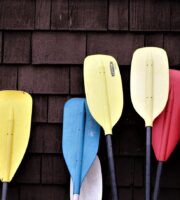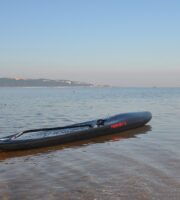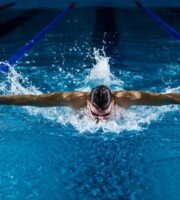Canoe polo, also known as kayak polo, is one of the competitive disciplines of kayaking that its fans simply call polo.
Each team has five players on the field (and up to three substitutes) who compete to score against an opponent’s goal, which is suspended two meters above the water. The ball can be thrown by hand or tossed with a racket to pass between the players and hit the goal. Dugouts can be set up in pools or on any 35-by-23-meter stretch of flat water.
Kayak polo combines boat and ball skills with a contact team game in which tactics and positional play are as important as the speed and physical fitness of individual athletes. The game requires excellent teamwork and develops both general canoeing skills and a number of other techniques unique to the sport. Kayaks are specifically designed for polo and are faster and lighter than conventional kayaks, which gives them excellent maneuverability.
The polo paddle blades have thick, rounded edges to prevent injury. The paddles are also very light and are designed with both traction and ball control in mind. Bumpers for the bow and tail of the boat, body protection, helmets and face shields are all a must.
History
The birth of the modern sport can be considered the demonstration event held at the National Canoe Exhibition at the Crystal Palace National Sports Centre in London in 1970. In response to the interest aroused at the Crystal Palace event, the first national sub-committee of the British Canoe Polo Union was formed and it was this committee that developed the modern framework of the game.
National championships were held each year at the National Canoe Show, and this event led to the inclusion of canoe polo in the demonstration games in Duisburg , Germany, in 1987.
In India, canoe polo was initiated by Kashmir University in Srinagar in 2008 when the university’s water sports coach, Muhammad Yusuf, held a promotional match between Kashmir University and Islamia College on the waters of Lake Nigin in Srinagar. The event was later added to the university’s annual water sports calendar.
The J&K Water Sports Association also promotes the sport in Jammu and Kashmir on a larger scale.
Features
The game is now played in many countries on all inhabited continents for recreation and serious sport. The sport holds world championships every two years, and between years of world championships there are annual continental championships in Europe, Asia, Africa and Panamerica. Internationally, the sport is organized by the Canoe Polo Committee of the International Canoe Federation as one of the disciplines of canoeing. Finnish Canoe Polo Championship, Lahti , Finland, 2010. Practice on the River Cam , England, 2004.
The game is often described as a combination of water polo , basketball and kayaking . The tactics and play of the game are similar to basketball or water polo, but with the added complexity of boats that can be used to tackle an opposing player in possession of the ball, or to fight for position within 6 meters of the goal.
Officials
There are two officials (one on each sideline), and they walk, not boat. The score is kept by the secretary, and a timekeeper keeps track of game time and penalty time. The goal lines are monitored by two linesmen. Inspectors check all equipment for compliance with the rules before the game begins.
Serving
Canoe polo is played either indoors in pools or outdoors on a 35-by-23-meter field. The boundaries of the field are ideally marked with floating ropes (similar to lane markers in swimming), although pool edges are often used for smaller venues. An area about 6 meters in front of each goal can be defined as the Zone. In this area, defending players create structures to protect the goal from attackers.
Timing
The game is officially played as a 14 to 20 minute game, consisting of two halves of 7 to 10 minutes. Teams change ends at halftime, which lasts 1 to 3 minutes. Each half begins with a “sprint” where each team lines up against their goal line and the referee throws the ball into the middle of the field. One player from each team runs to get possession of the ball. Shot clock A shot clock can be used to speed up play. The attacking team has 60 seconds to take a shot on goal or they will lose the ball. The shot clock is reset when the opposing team intercepts the ball or the attacking team loses possession. The shot clock is a recent addition to the rules, and because of the cost and complexity of the equipment, it is not universally used.







